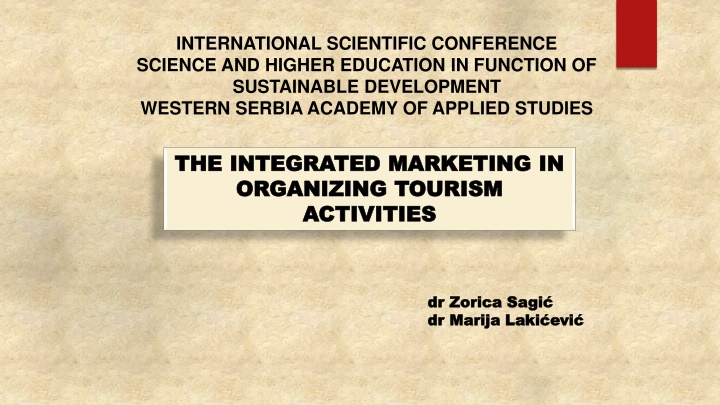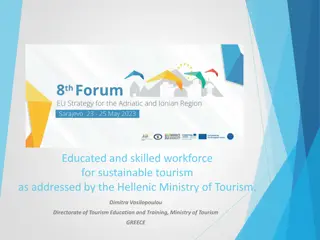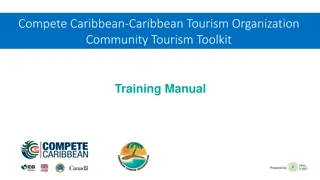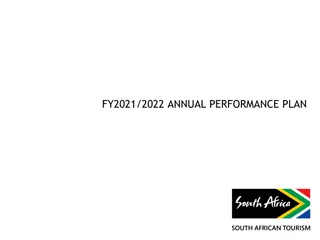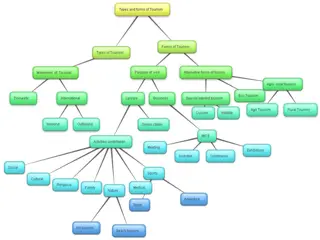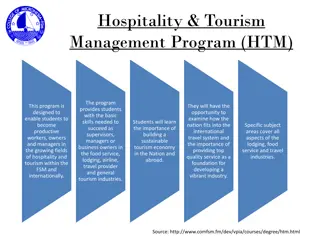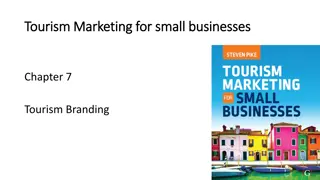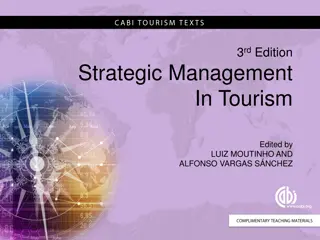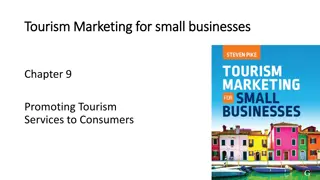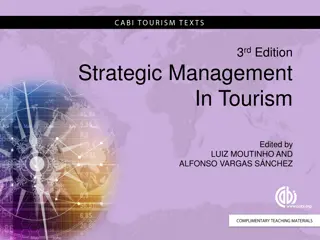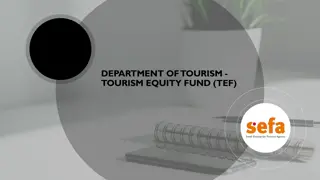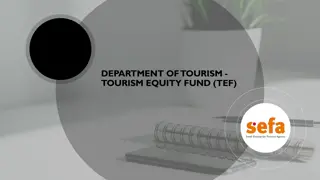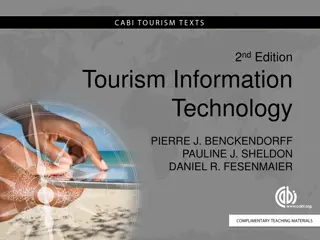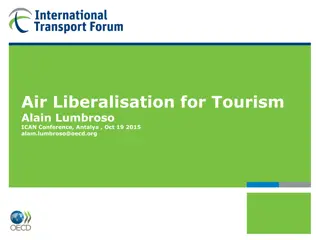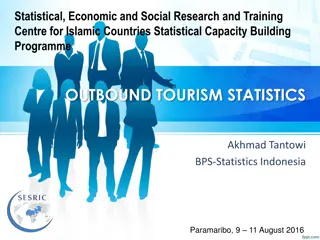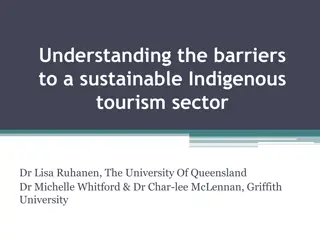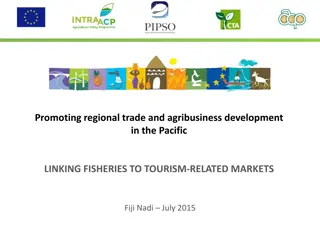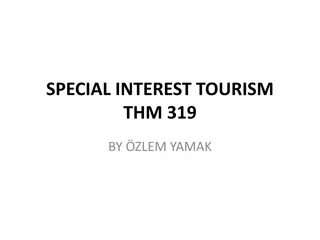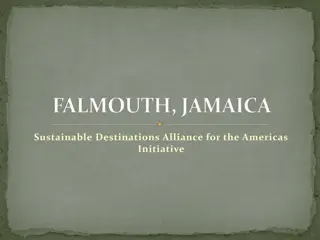Integrated Marketing in Tourism Industry for Sustainable Development
Marketing plays a vital role in the tourism industry, aiding companies in navigating competition and meeting tourist demands. This paper delves into the importance of marketing in tourism, focusing on organizing tourism activities and integrated marketing strategies. Explore the significance of marketing for efficiency and industry growth, with a special emphasis on the integrated efficiency of tourism activities.
Download Presentation

Please find below an Image/Link to download the presentation.
The content on the website is provided AS IS for your information and personal use only. It may not be sold, licensed, or shared on other websites without obtaining consent from the author.If you encounter any issues during the download, it is possible that the publisher has removed the file from their server.
You are allowed to download the files provided on this website for personal or commercial use, subject to the condition that they are used lawfully. All files are the property of their respective owners.
The content on the website is provided AS IS for your information and personal use only. It may not be sold, licensed, or shared on other websites without obtaining consent from the author.
E N D
Presentation Transcript
INTERNATIONAL SCIENTIFIC CONFERENCE SCIENCE AND HIGHER EDUCATION IN FUNCTION OF SUSTAINABLE DEVELOPMENT WESTERN SERBIA ACADEMY OF APPLIED STUDIES THE INTEGRATED MARKETING IN THE INTEGRATED MARKETING IN ORGANIZING TOURISM ORGANIZING TOURISM ACTIVITIES ACTIVITIES dr dr Zorica Zorica Sagi dr dr Marija Marija Laki evi Laki evi Sagi
INTRODUCTION INTRODUCTION The use of marketing is a prerequisite for tourism companies to be successful in conditions of increasing competition. Marketing in tourism makes contribution to and facilitates the process of exchange in the international and domestic tourism markets. In In the the paper organization organization marketing, marketing, as tourism tourism business business. . paper we we will of of as well well as will consider consider the tourism tourism as its its importance importance for the basics basics of industry, industry, of marketing marketing in especially especially for the the efficiency in the the integrated integrated efficiency of of
MARKETING FOR TOURISM INDUSTRY The main goal of marketing for tourism industry includes: collection, processing, storage, control and analysis of data and information on the tourist market; promotion of tourism supply and demand, as well as consumption possibilities; placement of an integral tourist product in order to satisfy the tourists' wishes and needs; communication with the market, in order to objectively inform the market about the state and development of the tourism offer; and marketing policy in tourism industry, in the form of development strategies and tactics.
The The tourist the the tourism tourism marketing tourist product product is marketing mix is a a central central part mix. . part of of Product Also Also there promotion promotion instruments instruments of mix, mix, because because they possible possible changes changes in there are are opinions opinions that are are of the the tourism they are in the the tourism that price price and more more tourism marketing marketing are adaptable adaptable to tourism market and efficient efficient Marketing mix Price Place to market. . The The instruments instruments of must must be be harmonized because because the realized realized profit profit depends their their optimal optimal combination of the the marketing marketing mix harmonized with with each the final final realization, realization, i i. .e e. . the depends on combination. . mix Promotion each other, other, the use of Scheme 1. Basic instruments of marketing mix on the the use of
When tourism industry, we are talking about two forms of application: applying marketing in marketing companies, income at the tourism market; and of generating individual their hospitality industry, hospitality industry, hotel industry, hotel industry, tourism mediation, tourism mediation, passenger turnover passenger turnover marketing at the individual area level. the macro approach the macro approach to the application of to the application of marketing marketing
The The application application of from from operational operational goals Strategic Strategic goals goals are policy policy of of marketing marketing drivers, to to be be the the goals goals of development development. . Setting an adequate goal means setting a realistically possible goal, and whether it will be achieved depends on a number of factors such as: the market situation, available staff, financial capabilities, etc. of marketing marketing in goals. . are those those that drivers, while of individual individual companies in tourism tourism distinguishes distinguishes strategic strategic that are while operational operational goals companies involved are set set within within the the global global tourism goals are are considered considered involved in in tourism tourism industry tourism industry
Marketing in tourism industry at the "micro" and "macro" levels individual marketing behaviour of a particular company (or consumer) M Micromarketing icromarketing" in tourism industry industry " in tourism aggregate marketing behaviour, i.e. the behaviour of the entire marketing system M Ma acromarketing cromarketing" in tourism industry industry " in tourism
M Micro icro- -level level level of implementing implementing various instruments instruments and level marketing marketing management of a a tourism tourism company company and various strategies and finding finding their is management management at and practically practically consists strategies related related to their optimal optimal combination combination. . management is at the the consists of marketing mix of to marketing mix Management Management at the the macromarketing macromarketing model society society controls controls (formally at the the macro macro level model by (formally or level implies implies the by the the authorities authorities that or informally informally) ). . the application application of of the that the
APPLICATION OF INTEGRATED MARKETING IN TOURISM INDUSTRY There are three levels of coordination which are important in establishment integrated marketing in tourism industry: mutual coordination of all activities; mutual coordination of sectors (in the company); and coordination at the macro level (the company itself in relation to the environment). The coordination of marketing activities between tourism companies and various tourism policy drivers at the macro and micro level is especially important for application of tourism industry. integrated marketing in
Interaction in the "production" of services includes the following domains: 1. Interaction between producers and consumers it's very important for the quality of the service (e.g. a tired passenger on arrival at the hotel has the first contact with the receptionist, and he has a very important function to reduce consumer tension and offer appropriate service); 2. Interaction between the consumers themselves they basically create the spirit and atmosphere in which the service is consumed (e.g. it can be the atmosphere that is established in a restaurant or bus during a group trip); 3. Interaction between the producer and the system in which the service is produced; 4. Interaction of environment and consumer this relationship can take really diverse forms (e.g. hotel design says a lot about style and level of service).
+ + SERVUCTION PRODUCTION PRODUCTION SERVICE SERVICE In integrated marketing in tourism industry, "servuction" should mean the following: establishing marketing at all levels; careful setting of operating procedures; well-developed support system; and effective coordination.
In the strategic approach to successful integrated service marketing, four phases are suggested: Emphasizing the importance of consumers; Emphasizing the importance of direct contact with consumers; Emphasizing the importance of an adequate support system; and Emphasizing the importance consumer dissatisfaction. of minimizing
Integrated marketing for hotel companies Each hotel company is suggested several basic tasks in the context of strategic marketing efforts, as a prerequisite for successful business: Planning the most profitable business mix of segments and products; Determining the position (positioning) and image for each of the parts (in the hotel chain); Developing the concept of "frequent users"; Development of integrated marketing between individual parts of the chain (hotels in the chain), or voluntary cooperatives if the hotel is independent. One of the most frequently applied nowadays is the concept of "frequent users", "bonus" or "club system", which reflects the effort to include the environment (tourists) in the business policy of the company, which objectively expands the areas of integrated marketing.
Integrated marketing for travel agencies The business policy of tour operators (which includes the application of integrated marketing) can be based on various elements of distinctiveness: Period during the year for which products are formed (off-season, season, as well as narrower time periods and different segments); Type of transport (most often it is air transport, but other types of transport are also used); Types of accommodation and their category (all forms of basic and some forms of complementary accommodation); Content of accommodation and food service (full board, half board, etc.); Length of stay; and Number of tourist destinations (usually not large number of destinations).
Integrated marketing for the national tourism organization A consistent marketing approach of any NTO should include several elements: I - Analysis of the current situation (internal focus): Analysis of basic indicators of existing demand and consumption; The country's position at the tourism market; Analysis of the basic elements of the tourist product (weaknesses and strengths); Promotional mix analysis; and Analysis of the compliance of the promotion with other instruments of market performance. II - Strategy as a vision (external focus): Strategy of promotion (and other instruments) in the context of other strategic approaches to the external environment; Characteristics of foreign and domestic tourism demand and trends; Characteristics of the environment (demographic, sociological, political, technological, economic); Opportunities and threats at the tourism market; Defining priority markets and segments, Goals to be achieved; and Positioning and other strategies.
CONCLUSION From From the necessary necessary for (foreign (foreign or The The absence absence of business business: : inability inability to inability inability to decline decline in the above above it it can for the or domestic) domestic). . be concluded concluded that the survival can be survival and that a a number number of competitiveness of of integrated integrated marketing of the the tourism tourism company marketing activities company at at the activities are the market market are and competitiveness of such such activities activities could could have have negative negative consequences consequences for for the the tourism tourism to exploit exploit market to maintain maintain the in the the overall overall quality market potential, potential, the level level of quality of of demand demand for of tourism tourism services, for tourism tourism services, services, etc etc. . services, The key to the success of tourism companies increasingly depends on understanding the place and role of integrated marketing and strategy as a planned decision through which to communicate with the environment.
